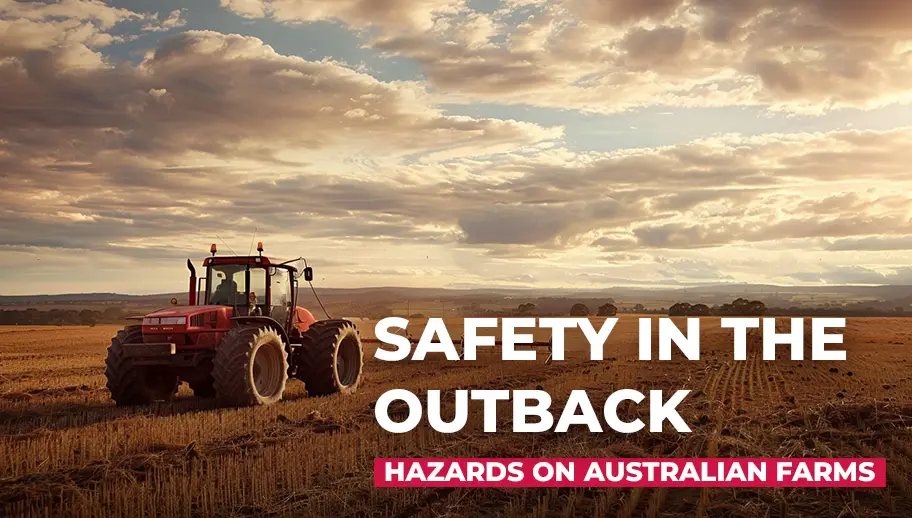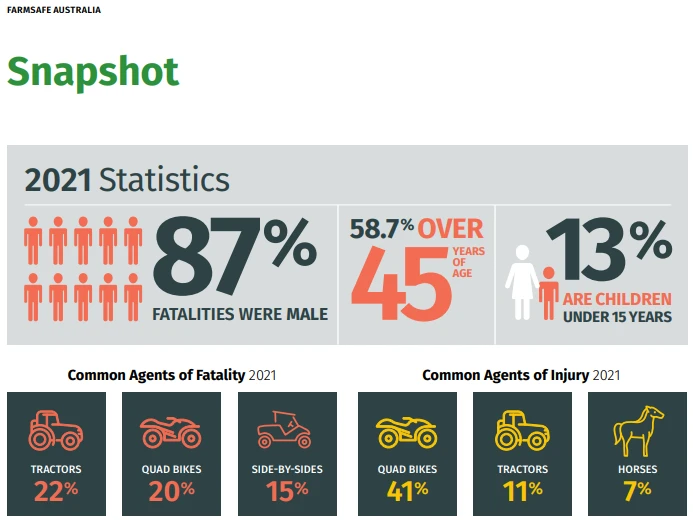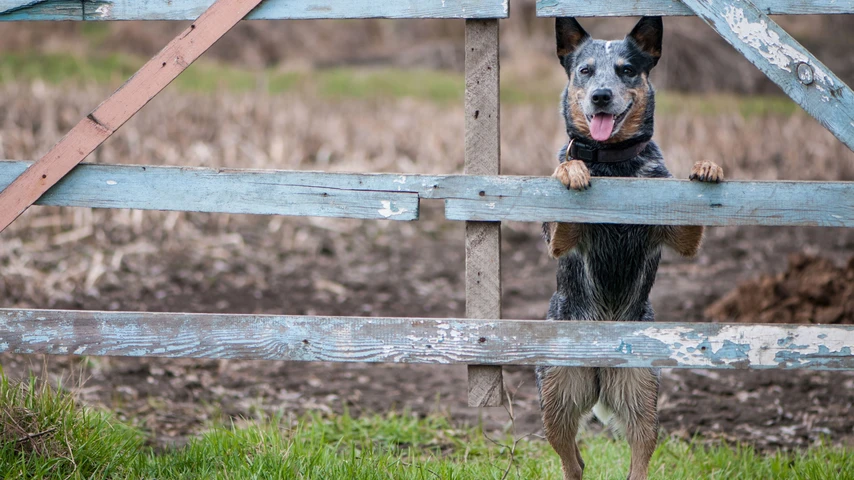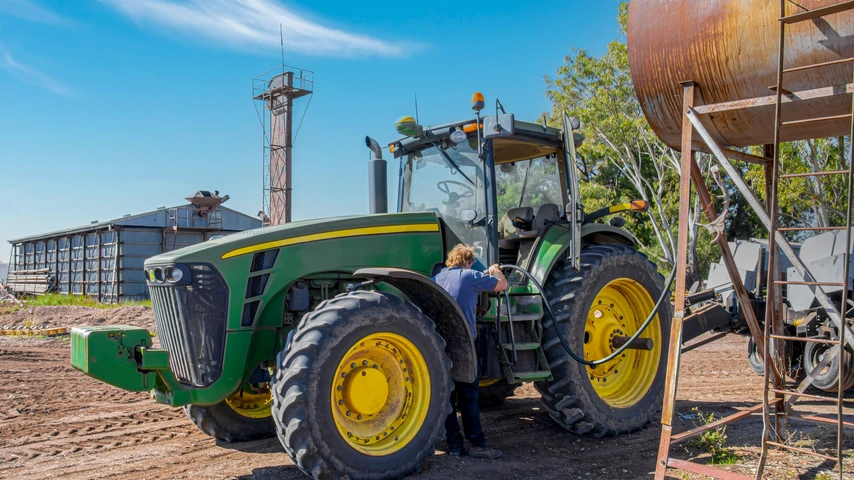Hazards on Australian Farms


Farming is the backbone of Australia. Providing our population with the food and textiles we need, the role that farm workers play is a vital one.
But farming is a uniquely dangerous occupation. The array of injuries sustained is vast, and risks and hazards on Australian farms can arise from:
Farmers often pride themselves on their self-reliability and stoicism. With their isolation comes a responsibility for self-maintenance, and the time-sensitive pressures of the job influence working practices. Being far from the nearest hospital means farmers rely on themselves and their colleagues for safety and for first aid treatment.
Safety-culture in farming is complex as new technologies supersede traditional practices. Safety training can be haphazard, with risk-taking behaviour a cultural norm. This sort of behaviour is commonly passed from generation to generation which further embeds it in the daily life on the farm.
Regulatory standards are hard to embed and enforce, and farmers are more likely to accept advice from other farmers. The farming community is strong and proud and must take steps to ensure the safety of everyone on the farm.
Farming is one of the most dangerous occupations in Australia. According to Better Health farming has about 8 times the rate of fatality of the general employed population.
An average of 52 farmers were killed in work-related incidences per year for the past 20 years. Vehicles made up about 39% of major injuries, and machinery accounted for about 26%. Just over half of all work-related farming incidences involved workers over 55 years of age.

With the advance of technology, farms are using more machinery and vehicles than ever before. This in turn leads to an increase in hazards. Equipment and vehicles account for the majority of injuries and deaths on Australian farms, with some common incidences being:
Read more about machinery and vehicle safety on Australian farms here.
As the saying goes, the dose makes the poison. Everything is a chemical, but the dose of that chemical is what can make it dangerous.
Farm workers are often dealing with very large quantities of hazardous substances such as cleaning products, herbicides, pesticides, fertilisers, process-specific chemicals, and even water.
Exposure to some of these substances, over a short or prolonged period, can lead to:
You can read more about farm chemical safety here.

Farm animals can pose a range of significant hazards for farm workers. Their size, strength, and unpredictability are often overlooked due to the need for speedy processing.
When working with animals, farmers are at risk of:
Gaining good working knowledge of the behaviours and temperaments of the animals on the farm can help reduce the likelihood of injury. Read more here.
Big machinery brings big noise. Large numbers of livestock also bring big noise. Even strong and steady winds bring big noise.
All of this noise can permanently damage workers’ hearing. Occupational hearing loss is an often-overlooked hazard, and as such it is important to be vigilant about noise levels in each work area.
Farm workers can be exposed to dust through many different sources:
Occupational lung diseases can occur due to exposure to some of these hazards, developing rapidly or over prolonged exposure. Some of these outcomes can result in disability or shortened life span.
Read more about the hazards of dust on Australian farms here.
Working outdoors can be an incredibly rewarding experience. Constant fresh air is a blessing, but constant exposure to the elements can be very damaging.
Sun exposure increases the risk of skin cancers, and wind can damage skin, eyes, and ears.
Extreme temperatures pose their own hazards, with heat exhaustion common in outback Australia. On the other hand, exposure to freezing temperatures brings a risk of frostbite and hypothermia.

Farms can be safe places to work, as long as care is taken to follow the appropriate regulations. Personal protective equipment should be provided to mitigate hazards across each are of the farm. Examples include:
Chemicals should be labelled, stored, used, and sign-posted according to their safety data sheets. All workers should be trained in their safe handling, storage, and exposure treatment. Training should include reviewing safety data sheets, which have emergency first aid instructions for each chemical. Maintain workplace exposure standards for certain airborne chemicals, with appropriate health monitoring.
Substituting dusty substances for liquids or granular formations and using less hazardous chemicals where possible are recommended safety procedures.
Ensuring adequate ventilation of enclosed areas can assist with dust and toxic fumes. Conversely, using vehicles and machinery with enclosed cabins can protect against exposure.
Maintaining appropriate guards in place for all machinery and vehicles, and ensure all animal enclosures are well maintained.
Never work alone with animals. Seek prompt medical attention for any injury sustained while working with animals, particularly needlestick injuries during animal vaccinations.
Farmsafe Australia has identified complacency as a real and persistent hazard on Australian farms. Workers can become complacent over time, and this increases the risk of injury or death.
Ensuring your first aid training is up to date is one way to combat complacency and puts you in a position of power to help those on your farm (including yourself) when an injury occurs.
Adequate first aid training can mean the difference between life and death on Australian farms.

October 1, 2024
Almost every job involves using the body to carry out some type of manual task. Some tasks may be hazardous, causing injuries such as musculoskeletal disorders (MSDs). Knowing how to manage them is a legal responsibility of all workplaces.

January 10, 2024
In Australia, workplace safety is a top priority, and First Aid plays a crucial role in ensuring the well-being of employees. Workplaces are expected to adhere to specific regulations and guidelines outlined by Safe Work Australia. How does your workplace stack up?

November 24, 2023
No matter how experienced you are as an outdoor activity leader, there are some things you should always do to keep your group safe. Nature can be unpredictable, and so it’s best to be prepared.